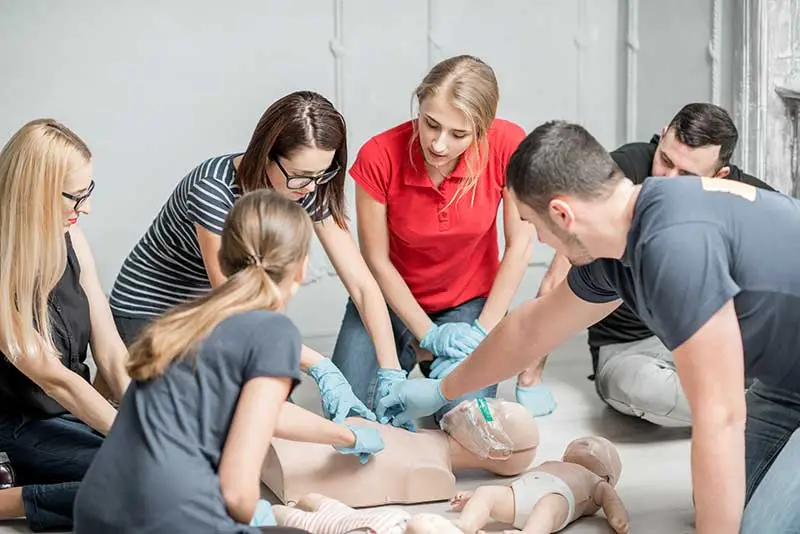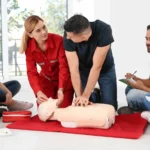In the United States, cardiac arrest affects more than 356,000 people annually, making it a leading cause of death. However, prompt CPR can double or triple survival rates. Thus, acquiring CPR skills is vital. Every year, approximately 88% of cardiac arrests occur at home, where immediate CPR by a bystander can make a crucial difference. Moreover, nearly 290,000 in-hospital cardiac arrests occur each year. Hence, no one can negate the importance of CPR healthcare provider training.
Let’s look at why healthcare professionals must be CPR-trained and how the knowledge and skills are helpful during an emergency.
Which life-saving courses should healthcare providers take?
Many life-saving courses aid healthcare providers. While some courses revolve around taking basic care of the patients, some train you on emergency procedures that can save lives.
Some courses that can help medical professionals during an emergency include Basic Life Support (BLS), Advanced Cardiovascular Life Support (ACLS), and Pediatric Advanced Life Support (PALS) certification. Here’s all you need to know.
- BLS and cpr course in ottawa teach essential CPR techniques for adults, children, and infants. It covers chest compressions and rescue breaths.
- ACLS courses focus on advanced cardiac care techniques. You learn about interpreting electrocardiograms (ECGs) and administering medications during cardiac emergencies.
- PALS courses equip healthcare providers with advanced skills. These new skills help them to respond to pediatric medical emergencies. On completing this course, you can help with CPR, airway management, and defibrillation.
Enrolling in the right online CPR healthcare provider course
While a CPR course is essential, you must connect with the right provider for proper training and well-recognized certification. Keep the following in mind when choosing a certification provider:
1.Provider’s reputation
- Opt for a recognized certification provider. Research popular online CPR courses endorsed by reputable healthcare organizations.
- Ensure CPR training and certification meet industry standards. Your employers and regulatory agencies should also accept this certification.
2. Check the course curriculum
- The curriculum must cover the required topics for healthcare provider certification. It should include adult, child, and infant CPR techniques. The right course will also teach you AED usage and choking relief.
- Confirm that the course aligns with current ECC CPR guidelines. If your course follows the right protocols, you will benefit from it.
3. Evaluate learning materials
- Assess the quality and comprehensiveness of the learning materials provided.
- Look for courses that offer engaging and interactive content to enhance understanding and retention of CPR skills.
4. Consider flexibility and support
- Determine the course schedule’s flexibility and instructor’s availability to accommodate your professional obligations and learning needs.
- Choose a course that offers access to knowledgeable instructors who can guide and assist throughout the training process.
5. Review user feedback
- Look at what other people say about the online CPR course. See if they liked it and found it helpful.
- Pay attention to their opinion on what they learned, how helpful the instructors were, and if they enjoyed attending the classes.
6. Verify certification validity
- Ensure the CPR certificate you get after finishing the course is for healthcare workers. Check if employers and official groups recognize it.
- Be aware of its validity and how often you must renew it.
7. Compare pricing and value
- Compare the cost of different online CPR courses and what you get for your money. Look at the length of the course, the material included, and any extras they offer.
8. Make an informed decision
- After reviewing everything, choose the online CPR course that seems best for you.
- Check the lessons, materials, and flexibility of the course. Also, consider the support, what others said, how valid the certification is, the price, and whether it’s worth it.
Following these steps and carefully considering your options, you can enroll in the right online CPR healthcare provider course. You will then meet all standards and receive high-quality training in life-saving CPR techniques.
Benefits of finding the right course
With the right course, you can get a recognized certification. It will allow you to practice CPR for those in need. Some other benefits of finding the right course include:
- Online CPR courses let healthcare workers learn at their own pace, fitting their busy schedules.
- They give access to helpful materials like digital books, videos, and quizzes to help learn CPR well.
- Joining a recognized online CPR course means getting a certificate that employers and regulators recognize. Online courses give you the flexibility to study.
- Doing a CPR course makes patients feel safe and can open up more job opportunities for healthcare providers.
- Taking an online CPR course is a smart move for medical professionals to learn or renew their life-saving skills.
- Picking the right course helps healthcare professionals prepare for emergencies and help patients more effectively.
- A valid certification means you are legally eligible to practice CPR and save lives during emergencies.
Conclusion
Consider user feedback, certification validity, and course price before choosing the best online CPR healthcare provider course for yourself. The right choice will give you access to top-notch training to become skilled in life-saving CPR techniques.





